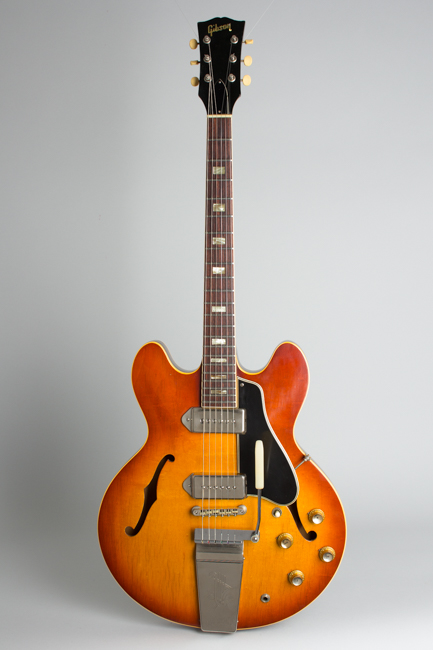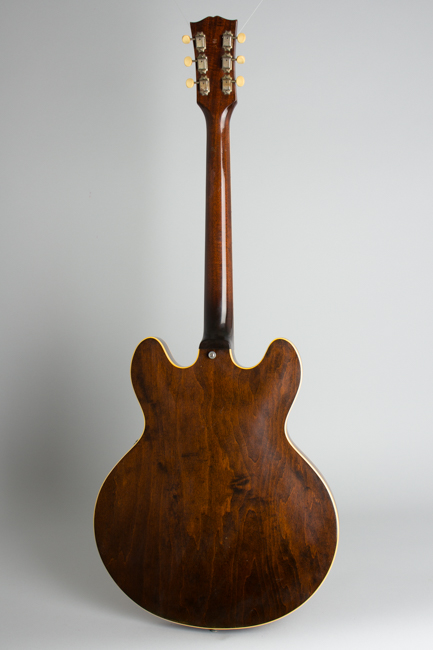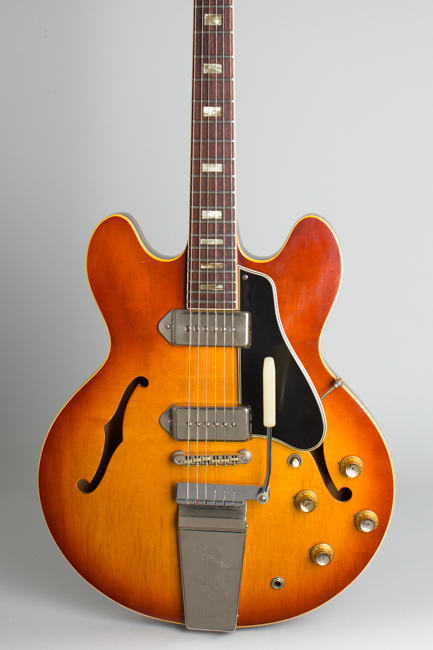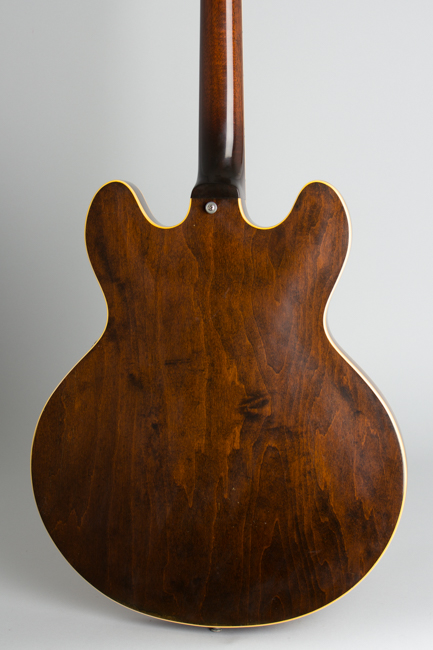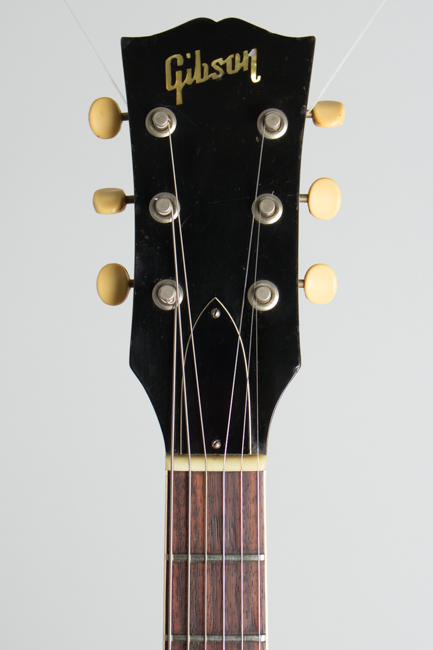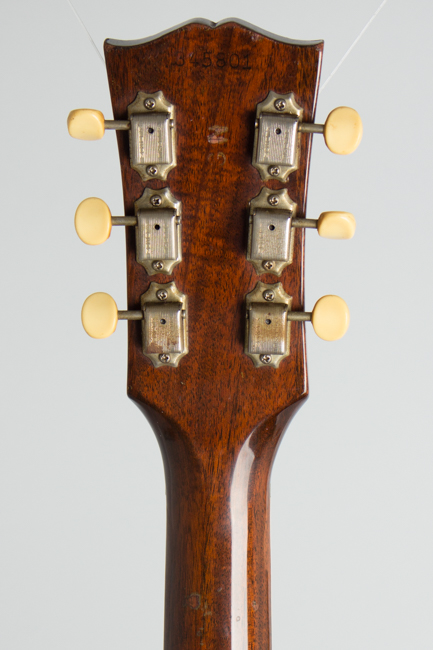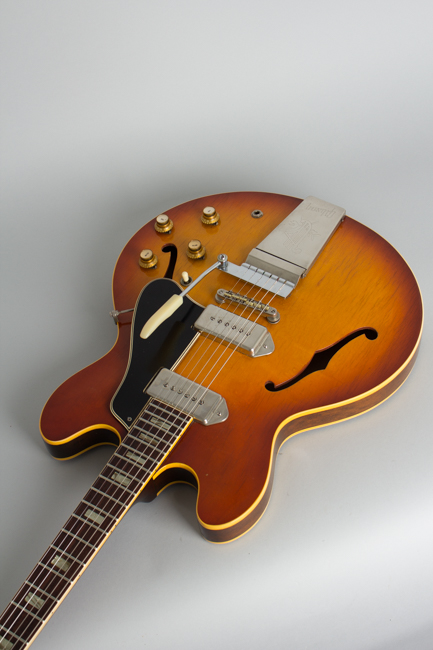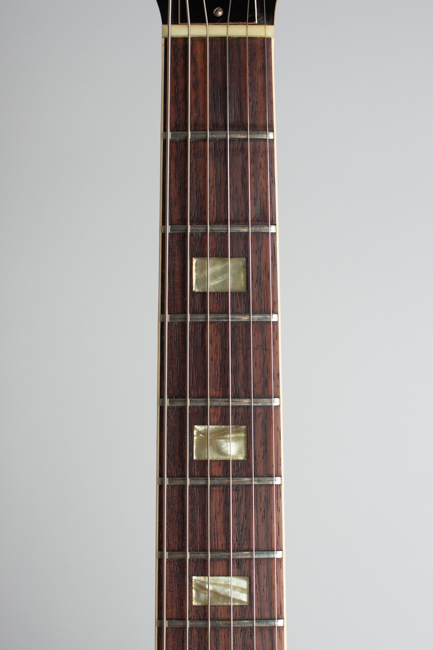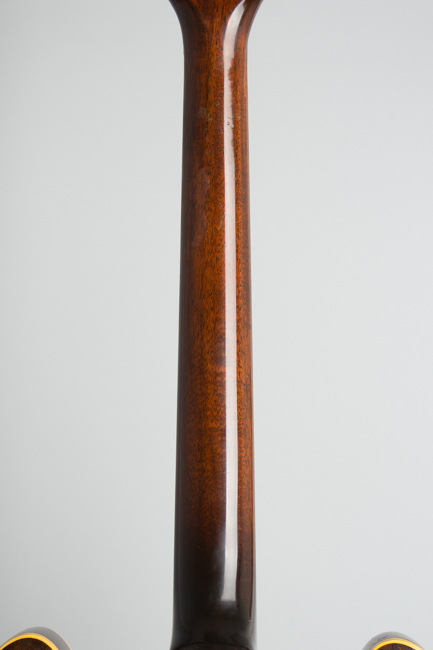Gibson ES-330TD Thinline Hollow Body Electric Guitar (1965)
This item has been sold.
Item # 8502
Prices subject to change without notice.
Gibson ES-330TD Model Thinline Hollow Body Electric Guitar (1965), made in Kalamazoo, Michigan, sunburst lacquer finish, laminated maple body; mahogany neck with rosewood fingerboard, black hard shell case.
This is a nice original example of a sunburst-finished Gibson ES-330 from 1965, with a fairly rare factory-fitted Vibrola tailpiece. The top has a nicely blended fairly light "ice tea" sunburst finish, with a dark finished body and neck. Other typical period features include a bound rosewood fingerboard with pearloid block inlay and mixed nickel and chrome-plated hardware including a Tune-O-Matic bridge with nylon saddles. The single-bound body is fully hollow, and the neck joins at the 16th fret. The tuners are single enclosed Kluson deluxe with plastic buttons. Two P-90 pickups are mated to the standard Gibson wiring rig, with '60s-style "capped" plastic tone and volume knobs (replaced the next year with the less attractive "witch hat" knobs) and white switch tip.
The ES-330 is a great sounding, very versatile guitar at home in many musical situations. Despite being intended by Gibson as an "amateur" instrument (the least expensive of the double-cutaway thinlines), the 330 has been heard on countless classic records in many styles of music since its introduction in 1959. Jazz great Grant Green used this model extensively on his most well-regarded early 1960s recordings. A number of period bluesmen have been spotted with one as well, including B.B. King, Chuck Berry, and most notably Slim Harpo, who is nearly always pictured with one. The 330 and its nearly identical sister guitar the Epiphone Casino were featured in countless '60s British invasion bands, including the Beatles, Rolling Stones, Kinks, Manfred Mann, the Merseybeats, and many more.
Overall length is 40 1/2 in. (102.9 cm.), 16 in. (40.6 cm.) wide at lower bout, and 1 3/4 in. (4.4 cm.) in depth, measured at side of rim. Scale length is 24 3/4 in. (629 mm.). Width of nut is 1 5/8 in. (41 mm.). Overall this is a very clean and original guitar with a few small oddities. It has a stamped mark "GN" on the back of the headstock, likely part of an intended "BGN" stamp indicating the original inspector found a flaw and the guitar was marked as a "bargain" to be sold off through alternate channels, not a Gibson dealer. It also has a Epiphone-style peaked truss rod cover that appears to have always been there. Regardless of these factory glitches this is still a great playing and sounding guitar, with only some fairly light wear overall and no obviously visible flaws.
This guitar has one notable if invisible alteration of a type we have seen a few times over the years. In the late 1960's and early '70's the volume levels many folks routinely played at made the previously extremely popular ES-330 prone to feedback issues, and they disappeared from most professional bands. There were various attempts to remedy this, usually involving stuffing something into the body or taping off the F-holes. This one has had a far more elegant and discreet solution: small wood blocks added between the top and back under the bridge and the area between the pickups. This makes the guitar slightly heavier (the vibrato adds to that too) but tightens up the sound just a bit, and does help with the feedback -- although most players no linger play as loud as days past and it's far less of an issue in the 21st century! A slightly quirky but still cool vintage whammy-equipped 330, residing in a nice purple-lined Gibson HSC from the early '70's. Overall Excellent Condition.
This is a nice original example of a sunburst-finished Gibson ES-330 from 1965, with a fairly rare factory-fitted Vibrola tailpiece. The top has a nicely blended fairly light "ice tea" sunburst finish, with a dark finished body and neck. Other typical period features include a bound rosewood fingerboard with pearloid block inlay and mixed nickel and chrome-plated hardware including a Tune-O-Matic bridge with nylon saddles. The single-bound body is fully hollow, and the neck joins at the 16th fret. The tuners are single enclosed Kluson deluxe with plastic buttons. Two P-90 pickups are mated to the standard Gibson wiring rig, with '60s-style "capped" plastic tone and volume knobs (replaced the next year with the less attractive "witch hat" knobs) and white switch tip.
The ES-330 is a great sounding, very versatile guitar at home in many musical situations. Despite being intended by Gibson as an "amateur" instrument (the least expensive of the double-cutaway thinlines), the 330 has been heard on countless classic records in many styles of music since its introduction in 1959. Jazz great Grant Green used this model extensively on his most well-regarded early 1960s recordings. A number of period bluesmen have been spotted with one as well, including B.B. King, Chuck Berry, and most notably Slim Harpo, who is nearly always pictured with one. The 330 and its nearly identical sister guitar the Epiphone Casino were featured in countless '60s British invasion bands, including the Beatles, Rolling Stones, Kinks, Manfred Mann, the Merseybeats, and many more.
Overall length is 40 1/2 in. (102.9 cm.), 16 in. (40.6 cm.) wide at lower bout, and 1 3/4 in. (4.4 cm.) in depth, measured at side of rim. Scale length is 24 3/4 in. (629 mm.). Width of nut is 1 5/8 in. (41 mm.). Overall this is a very clean and original guitar with a few small oddities. It has a stamped mark "GN" on the back of the headstock, likely part of an intended "BGN" stamp indicating the original inspector found a flaw and the guitar was marked as a "bargain" to be sold off through alternate channels, not a Gibson dealer. It also has a Epiphone-style peaked truss rod cover that appears to have always been there. Regardless of these factory glitches this is still a great playing and sounding guitar, with only some fairly light wear overall and no obviously visible flaws.
This guitar has one notable if invisible alteration of a type we have seen a few times over the years. In the late 1960's and early '70's the volume levels many folks routinely played at made the previously extremely popular ES-330 prone to feedback issues, and they disappeared from most professional bands. There were various attempts to remedy this, usually involving stuffing something into the body or taping off the F-holes. This one has had a far more elegant and discreet solution: small wood blocks added between the top and back under the bridge and the area between the pickups. This makes the guitar slightly heavier (the vibrato adds to that too) but tightens up the sound just a bit, and does help with the feedback -- although most players no linger play as loud as days past and it's far less of an issue in the 21st century! A slightly quirky but still cool vintage whammy-equipped 330, residing in a nice purple-lined Gibson HSC from the early '70's. Overall Excellent Condition.
